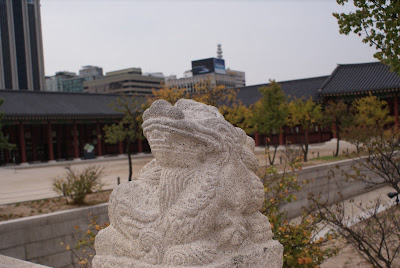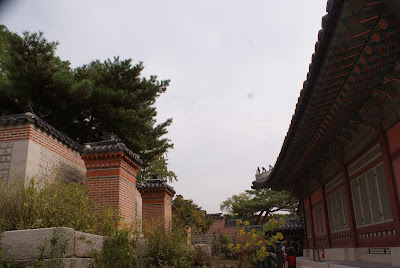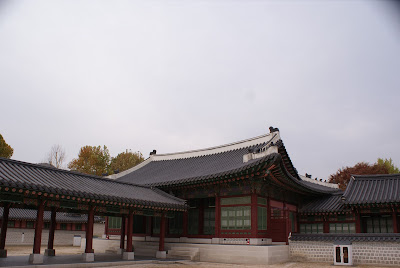All the Palaces including Gyeongbokgung Palace in Seoul were razed by the Japanese invasions (1592-1598). It was reconstructed in 1867 and some 330 buildings were built on a site of over 40 hectares. But it was largely torn down during the Japanese occupation (1910-1945), namely, ninety three percent of the restored buildings (36 buildings remaind).
An effort to fully restore Gyeongbokgung
Palace to its former glory has been ongoing since 1990.
* Open hours and Fee
- Nov to Feb: 09:00~17:00
- Mar to May, Sep to Oct: 09:00~18:00
- Jun to Aug 09:00~18:30
- Fee: KRW3,000
- Closed in Tue
* Free guided tours
- English 11:00, 13:30, 15:30- Japanese 10:00, 12:30, 14:30
- Chinese: 09:30, 11:00, 13:30, 16:30
* Transportation
- Subway: Line 3 Gyeonbokgung Station (transfer in Bulgwang Station from Eungam Station by Line 6) Entrance 5
- Bus: Get off Gyeongbokgung by No. 7022 from Eungam Station or No. 7212 from Shinheung Market

1. Palace Walls and Gates
A. Palace Walls
B. Gwanghwamun Gate
Gwanghwamun Gate is the main gate of the main Palace. The king used the central arch, while the crown prince and officials entered through the openings on either side. The gate pavilion housed a bell, which announced the time of day.
D. Yeongchumun Gate
The west gate means "autumn is welcomed." Complementing the name of Geonchunmun Gate in the east, Yeongchumun Gate was built to conform to the connotations implicit in the notions of "west" and "autumn." This gate was mainly used by civil and military court officials, in particular those who worked in the administrative buildings located in the west.
There is the Blue House (president office and residence) in the outside of this gate. After going out, anyone can reenter this gate freely with showing ticket. This area was a backyard of the palace.
F. Dongsibjagak Watchtower
This watchtower
is situated at the southeastern corner of the Palace. With the demolition of
the Palace walls, it sits in the middle of a busy intersection just like a lonely island. The western
watchtower on the other side of the Palace was torn down in 1923 during the
Japanese occupation.
2. Heungnyemun Gate
Compound
The corridors extending
out from Heungnyemun Gate form an enclosure. In the middle of this enclosure is
Geumcheon Stream, which was designed to flow through the Palace from the west
to the east after coming down from Mt. Baegak. A bridge called Yeongjegyo
is located at the center of this stream.
Officials of Rank 2 and above stood on the northern side of the bridge, while those of Rank 3 and below lined up on the south side. Only the king used the central path, while the crown prince and officials walked through the paths on either side.
3. Geunjeongjeon Hall Compound
Officials of Rank 2 and above stood on the northern side of the bridge, while those of Rank 3 and below lined up on the south side. Only the king used the central path, while the crown prince and officials walked through the paths on either side.
3. Geunjeongjeon Hall Compound
Geunjeongjeon Hall (meaning of "diligence helps governance") is the Throne Hall, where the king granted audiences to his officials, presided over large official functions and met foreign envoys. There is a spacious courtyard in front, where important events were held and corridors enclose it.
Geunjeongmun Gate, the entrance to the Throne Hall enclosure, was where the
king and his officials gathered for weekly meetings. During major events, such as coronations and receiving foreign envoys, court
officials found their places according to the rank stones planted on the
courtyard. The courtyard is paved with thin, wide and rectangular stones. The
surfaces are finished rather roughly, so as to give a less monotonous look and
prevent the sun from blinding people standing on the courtyard.
The central building, "Geunjeongjeon Hall," symbolizing the state and the king, has a two-tierroof and the tops
of the pillars are elaborately decorated. Behind the throne is a
wall screen painted with the sun, moon and a five-peak mountain. A pair of
sculpted dragons decorates the ceiling.
On the steps and parepets, there are stone scuptures of phoenixes, Haetae (the legendary animal of judgment), and some animals.
* Some people may wonder what the nets under the eaves are. They are to protect the building from rats, birds, etc.
* Dancheong (traditional multicolored paintwork on wooden buildings) is said to be painted for performing ancestral rites, decorating a altar, or protecting wooden building from harmful insects. It has long history from 3 Kingdom period (more than 1,500 years ago).
4. Office Quarters
The Office Quarters were
where the king handled state affairs and studied Chinese classics with his
civil servants in normal times, or where he threw parties
for his relatives and ministers and supervised qualifying examinations for the
civil service.
Sajeongjeon Hall is a central building of the Office Quarters. The throne is at the center and hung on the wall is a painting of a pair of dragons slithering amid clouds. The Hall is not equipped with heated floors.
* Sajeong implies: "One gains if one thinks of the ways of the world, but loses if one does not think of them. Unless the king thinks deeply and examines carefully, he cannot distinguish right from wrong. He must ponder more deeply."
Gangnyeongjeon Hall is the king's living quarters and Gyotaejeon Hall is for the queen.
* Sajeong implies: "One gains if one thinks of the ways of the world, but loses if one does not think of them. Unless the king thinks deeply and examines carefully, he cannot distinguish right from wrong. He must ponder more deeply."
There are the two auxiliary halls on the left and the right, Manchunjeon Hall and Cheonchujeon Hall.
Gangnyeongjeon Hall is the king's living quarters and Gyotaejeon Hall is for the queen.
Behind Gyotaejeon Hall is an artificial
mound, Amisan, that is said to be the most beautiful and most mysterious. Flower terraces are laid
out on this hill, along with the chimneys that draw out smoke from the heating
flues in Gyotaejeon Hall. On the surfaces of the hexagonal
structures in the chimneys are wonderful patterns of vines, bats, phoenixes, pines,
apricot trees, chrysanthemums, herbs of eternal youth, rocks, birds and deer.
5. Jagyeongjeon Hall Compound
Jagyeongjeon Hall, located to the east of the living quarters, was built for the Dowager Jo, posthumously given the title of Queen Sinjeong, the adoptive mother of young King Gojong.
Behind Jagyeongjeon Hall,
chimneys are engraved with 10 signs of longevity (sun, mountain, water, stone,
cloud, pine, herb of eternal life, turtle, crane and deer), and designs of bats
and arabesque patterns.
6. Donggung the Crown Princess's Compound
This compound was where the crown prince lived with the crown princess, while he was in training for the throne. The Crown Prince's Compound consisted of two main buildings Jaseondang and Bihyeongak.
7. Gyeonghoeru Pavilion
Gyeonghoeru Pavilion, a
pavilion located on a pond to the west of the living quarters, was built as a
venue for feasts for foreign envoys and for the king and his court
officials.
Sujeongjeon Hall, located to the south of the pond with Gyeonghoeru Pavilion, was where Jiphyeonjeon(the Hall of Worthies) was situated during King Sejong's reign.8. Heumgyeonggak and Hamwonjeon
Buildings near the Inner Court served the needs of the royal household. Many of his scientific inventions, including the rain gauge, sundial and water clock, as well as instruments for astronomical observation, were installed in Heumgyeonggak. Hamwonjeon, a building used for Buddhist events, is also believed to have been built during King Sejong’s reign.
9. Hyangwonji Pond and Hyangwonjeong Pavilion
In 1873, when King Gojong
built Geoncheonggung Palace, he had a pond dug to the south, with an islet
created in the middle. A two-tier hexagonal pavilion, built on the islet, was
named Hyangwonjeong Pavilion and the wooden bridge leading to it was called
Chwihyanggyo.
The
sources of the pond are underground water and a spring coming down from the
mountain at the back of the Palace. The water eventually flows into the pond
where Gyeonghoeru Pavilion stands.
To the northwest of Gyeongbokgung Palace are various shrines, including Binjeon, Honjeon Hall and Yeongjeon. Binjeon Hall was where the caskets of the royal deceased were laid soon after their deaths. Honjeon Hall was where their mortuary tablets were housed for two years until they were sent to Jongmyo, the Royal Ancestral Shrine. Yeongjeon Hall displayed portraits of the deceased and rites were held in front of these images. Taewonjeon Hall Shrine held the portrait of King Taejo, the founder of the Joseon Dynasty. Later, it was used for other purposes, such as housing mortuary tablets and performing rites for the deceased.
11. Geoncheonggung Residence
This residence was built
in 1873(the 10th year of King Gojong). Located in a secluded place in the northernmost part of the
Palace, it was built for the king and the queen to enjoy peace and quiet.
The residence followed the architecture of a typical scholar's residence,
except for a few ornate decorations.
The first electric lights in the Palace were installed here. In 1895, a group of Japanese assassins raided this residence and slaughtered Queen Myeongseong, King Gojong's wife. She died in Okhoru, the high veranda of Gonnyeonghap.
12. Jibokjae, Hyeopgildang and Parujeong Halls
King Gojong used the buildings as an
art hall in which to enshrine royal portraits, a library and an audience hall
for the reception of foreign envoys.
13. Nae-sojubang, Oe-sojubang, Saengmulbang
Nae-sojubang was the kitchen where the king's daily food was prepared.


Oe-sojubang was the kitchen where food was prepared for feast such as king's birthday, traditional holidays, special occasions amd annual conferences.
Saengmulbang was the kitchen where a variety of dishes were prepared, including tteok (rice cake), gangjeong (ricke crackers), yakgwa (honey cookies), and diverse jeonggwa (fruits preserved in honey).
14. Huge Jars Terrace
There lies a huge terrace between Taewonjeon and Gyeonghoeru. Huge jars having soybean sauce, fermented soybean paste and hot pepper paste are stored.
* Please refer to the website of Gyeonbokgung Palace (http://www.royalpalace.go.kr/html/eng/main/main.jsp) for more information. Some writings and photos are copied from http://www.royalpalace.go.kr:8080/.






















































































































































댓글 없음:
댓글 쓰기